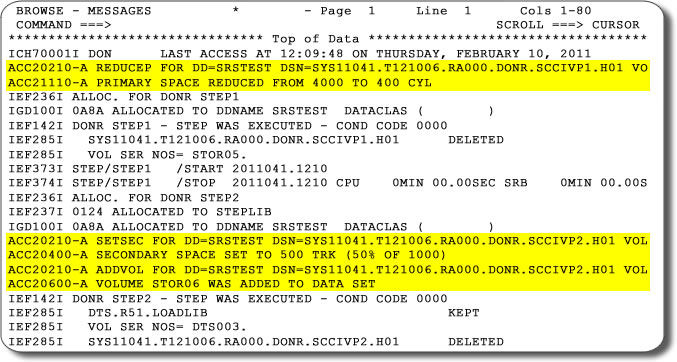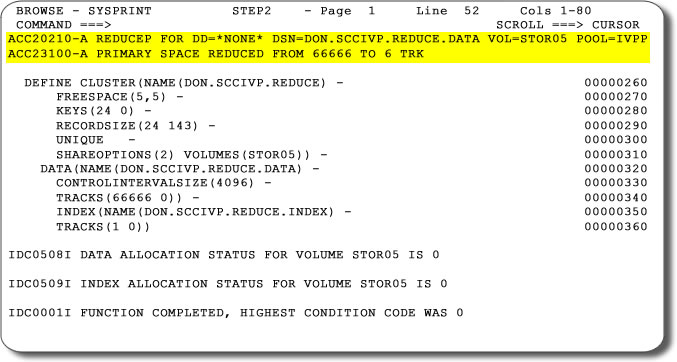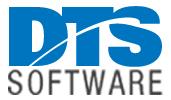Space Recovery System
Space Recovery System (SRS) eliminates production failures that occur when the available disk storage can’t meet application needs. SRS’s sophisticated recovery mechanisms identify available space and dynamically match the application requests to free space. With SRS, job failures and reruns due to out-of-space errors are a thing of the past! SRS:
- Prevents virtually all out-of-space errors – whether DB2, VSAM, non-VSAM, SMS-managed, disk or tape
- Improves throughput – no more need for costly production restarts and reruns, especially during peak workloads
- Eliminates human factors – removes the need to manually identify problems and find free disk space
- Improves disk space utilization – allowing more cost-effective use of expensive storage resources

SRS RECOVERY MESSAGES FOR SEQUENTIAL DATA SETS

SRS RECOVERY MESSAGES FOR A VSAM DEFINE CLUSTER
The Space Recovery System (SRS) eliminates all types of storage space-related errors. Whether the error is caused by application growth, out-of-date JCL, volume space fragmentation, or job conflicts, SRS steps in to dynamically modify space needs, find available space, and prevent failures. SRS not only improves system throughput, but provides a critical “safety net” that allows installations to achieve higher rates of disk space utilization than could ever be accomplished in any other way.
- Eliminate B37, D37, E37 abends and VSAM errors. SRS determines in advance when an out-of-space condition will occur and prevents the error. Production downtime and reruns due to space problems are eliminated.
- Support for all types of data. SRS can prevent problems for all types of datasets, SMS-managed or non-SMS, VSAM or non-VSAM, striped, extended-format, HFS, and others.
- Automatic Reorganization of Multivolume Datasets. When an application releases a dataset that SRS has extended to an additional volume, SRS can automatically invoke system utilities to copy the dataset back to a single volume if space is available.
- Catalog and Tape Error Prevention. SRS does more that just prevent DASD space errors. Duplicate dataset name and NOT-CATLGD-2 errors can be stopped, S837-08 tape errors can be eliminated, and output datasets can automatically be switched to tape units with non-empty automatic cartridge loaders.
- Extensions allow better control over space use. The SRSE function allows installations to automatically route desired datasets to VIO, limit dataset space requests, add RLSE parameters, choose optimal tape and disk blocksizes, and control other aspects of dataset usage.
SMF Analysis Program. This program will analyze installation SMF data and determine the number and cost of X37 abends. This self-extracting file contains a READ.ME entry that describes the installation procedure.
Improves System Throughput
- Eliminates production downtime
- Eliminates reruns due to space problems
- Prevents tape errors
- Reduces schedule interruptions
Reduces Production and System Costs
- Provides higher rates of disk space utilization
- Postpones purchase of additional DASD
- Eliminates production downtime
- Eliminates reruns due to space problems
Safeguards production window
- Provides critical “safety net”
- Eliminates production downtime
- Eliminates reruns due to space problems
- Assists with peak workloads via DASD efficiencies
Assists Applications Staff
- Handles DASD needs as applications grow
- Handles out-of-date JCL
- Eliminates re-reruns due to space problems
The marketing literature and webinars are available to all visitors. The product manuals are only available to registered customers and companies trialing DTS products – login is required. To request authorized access, please complete the Registration form. DTS customer support will review your request. Upon approval, you will receive access notification by E-mail within one business day.
“I cannot remember the last time I had a space abend. I know it has been years. SRS from DTS handles those problems so transparently that I forget it is installed.”
Bob Richards
VP, Enterprise Technologist
SunTrust Banks, Inc.
“SRS has allowed us to postpone a large DASD purchase due to higher device utilization. Space abends are a thing of the past.”
Technical Support Manager
Northeastern Pharmaceutical Retailer
“The DTS ACC/SRS product installation is quick and easy to follow. On those occasions when DTS technical support was required, I have always received prompt, accurate and courteous support from DTS technicians – they always exhibited technical expertise and professionalism.”
Elaine Finch
Bank of America
We have used DTS SRS software for years and it has worked flawlessly. It has been very easy to install and absolutely user friendly. Also the support cannot be beat!!
Mark Sisbarro
Ebsco Industries
Recently, we had a DB2 problem/issue involving DASD storage. Being a user of SRS, we got in touch with your support group and almost immediately they responded with a great update – pointing back to a user issue. The bottom line here is that I received a great reply in a matter of an hour or so, rather than waiting hours or days for some rep to tell us they need more documentation. That support has been getting rare among our vendors, so please feel free to pass along my thanks for a job well done by your support team!
Dave Kucharski
BlueCross BlueShield of Illinois
The owners of DTS Software wrote the original STOP-X37 recovery product in the early 80’s, and marketed the product through Empact Software. After a very successful startup and deep market penetration, the original development company (ETI) and Empact were purchased in the late 80’s. Three years later, the original STOP-X37 developers created DTS Software to write ACC for the Japanese market.
At that time, DTS had no intention of competing with STOPX37. The product had an insurmountable market penetration, rock solid stability, and the founders at DTS had no desire to compete with the original product. Three things happened that changed the situation:
-
The Removal of STOP-X37 – Boole and Babbage, the new owner’s of STOP-X37, purchased a European product called GO-SMS. After re-branding the product suite as PRO-SMS and renaming the X37 recovery component as STOP-X37 II, Boole upgraded the customer base to the new product. Since Boole charged for the upgrade, there was no easy way to return customers to the original STOP-X37.
-
Customer Need – The original STOP-X37 II had serious stability problems when released. The problems were magnified by the fact that the product was released into a large install base. The original developers now at DTS started getting calls and complaints about the new version – one of the pitfalls of giving out home phone numbers.
-
A New Design – Once it was obvious that STOP-X37 II was failing, DTS started talking about the possibility of creating another X37 recovery product. Technically and legally, DTS would have had no difficultly re-entering the market. However, the developers never considered recreating a technically similar product. Eventually, a DTS developer found a very clever way to perform X37 recoveries that used a much simpler algorithm than the original product.
Once DTS decided to re-enter the X37 recovery market, Boole was notified about the new product and DTS offered their engineers source-code access to the prototype. Eventually, Boole took the offer and verified that SRS used a completely different recovery algorithm. SRS was introduced to the market in 1994.

